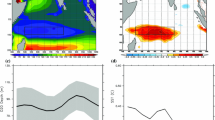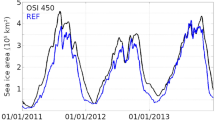Abstract
In order to simulate the climatic conditions of the Neoproterozoic, we have conducted a series of simulations with a coupled ocean–atmosphere model of intermediate complexity, CLIMBER-2, using a reduced solar constant of 6% and varied CO2 concentrations. We have also tested the impact of the breakup of the supercontinent Rodinia that has been hypothesized to play an important role in the initiation of an ice-covered Earth. Our results show that for the critical values of 89 and 149 ppm of atmospheric CO2, a snowball Earth occurs in the supercontinent case and in the dislocated configuration, respectively. The study of the sensitivity of the meridional oceanic energy transport to reductions in CO2 concentration and to the dislocation of the supercontinent demonstrates that dynamics ocean processes can modulate the CO2 threshold value, below which a snowball solution is found, but cannot prevent it. The collapse of the overturning cells and of the oceanic heat transport is mainly due to the reduced zonal temperature gradient once the sea-ice line reaches the 30° latitudinal band but also to the freshening of the tropical ocean by sea-ice melt. In term of feedbacks, the meridional atmospheric heat transport via the Hadley circulation plays the major role, all along the CO2 decrease, by increasing the energy brought in the front of the sea-ice margin but does not appear enough efficient to prevent the onset of the sea-ice-albedo instability in the case of the continental configurations tested in this contribution.












Similar content being viewed by others
References
Baum SK, Crowley TJ (2001) GCM Response to Late Precambrian (∼590 Ma) Ice-Covered Continents. Geophys Res Lett 28: 583–586
Bendtsen J (2002) Climate sensitivity to changes in solar insolation in a simple coupled climate model. Clim Dyn 18: 595–609
Bendtsen J, Bjerrum CJ (2002) Vulnerability of climate on Earth to sudden changes in insolation. Geophys Res Lett 29: 10.1029/2002GL014829
Bice KL, Scotese CR, Seidov D, Barron EJ (2000) Quantifying the role of geographic change in Cenozoic ocean heat transport using uncoupled atmosphere and ocean models. Palaeogeogr Palaeoclimatol Palaeoecol 161: 295–310
Bonfils C, De Noblet N, Braconnot P, Joussaume S (2001) Hot desert albedo and climate change: mid-holocene monsoon in North Africa. J Clim 14: 3724–3737
Budyko MI (1969) The effect of solar radiation variations on the climate of the Earth. Tellus 21: 611–619
Cawood PA, Nemchin AA (2001) Paleogeographic development of the east Laurentian margin: constraints from U-Pb dating of detrital zircons in the Newfoundland Appalachians. Geol Soc Am Bull 113: 1234–1246
Chandler MA, Sohl LE (2000) Climate forcings and the initiation of low-latitude ice sheets during the Neoproterozoic Varanger glacial interval. J Geophys Res 105(D16): 20,737–20,756
Claussen M et al (2002) Earth system models of intermediate complexity: closing the gap in the spectrum of climate system models. Clim Dyn 18: 579–586
Dalziel IWD (1997) Overview: Neoproterozoic-Paleozoic geography and tectonics: review, hypothesis, environmental speculation. Geol Soc Am Bull 109: 16–42
Donnadieu Y, Fluteau F, Ramstein G, Ritz C, Besse J (2003) Is there a conflict between the Neoproterozoic glacial deposits and the snowball Earth model: an improved understanding with numerical modelings. Earth Planet Sci Lett 208: 101–112
Donnadieu Y, Ramstein G, Fluteau F, Besse J, Meert JG (2002) Is high obliquity a plausible cause for Neoproterozoic glaciations? Geophys Res Lett 29(23): 2127, doi:10.1029/2002GL015902
Ganopolski A et al (2001) CLIMBER-2: a climate system model of intermediate complexity. Part II: model sensitivity. Clim Dyn 17: 735–751
Ganopolski A, Rahmstorf S, Petoukhov V, Claussen M (1998) Simulation of modern and glacial climates with a coupled model of intermediate complexity. Nature 391: 351–356
Gérard J-C, Hauglustaine DA, François LM (1992) The faint young sun climatic paradox: A simulation with an interactive seasonal climate-sea-ice model. Palaeogeogr Palaeoclimatol Palaeoecol 97: 133–150
Gough DO (1981) Solar interior structure and luminosity variations. Solar Phys 74: 21–34
Hoffman PF (1991) Did the breakout of Laurentia turn Gondwanaland inside-out? Science 252: 1409–1412
Hoffman PF, Schrag DP (2002) The snowball Earth hypothesis: testing the limits of global change. Terra Nova 14: 129–155
Hoffman PF, Kaufman AJ, Halverson GP, Schrag DP (1998) A Neoproterozoic snowball Earth. Science 281: 1342–1346
Hyde WT, Crowley TJ, Baum SK, Peltier RW (2000) Neoproterozoic ‘snowball Earth’ simulations with a coupled climate/ice-sheet model. Nature 405: 425–429
Jenkins GS, Frakes LA (1998) GCM sensitivity test using increased rotaion rate, reduced solar forcing and orography to examine low latitude glaciation in the Neoproterozoic. Geophys Res Lett 25: 3525–3528
Jenkins GS, Smith SR (1999) GCM simulations of snowball Earth conditions during the late Proterozoic. Geophys Res Lett 26: 2263–2266
Kaufman AJ, Jacobsen SB, Knoll AH (1993) The Vendian record of Sr and C isotopic variations in seawater: Implications for tectonics and paleoclimate. Earth Planet Sci Lett 120: 409–430
Kaufman AJ, Knoll AH, Narbonne GM (1997) Isotopes, ice ages, and terminal Proterozoic earth history. Proc National Academy of Sciences, United States of America 94: 6600–6605
Kirschvink JL (1992) Late Proterozoic low-latitude global glaciation: the snowball Earth. In: Schopf JW, Klein CC (eds) The Proterozoic biosphere: a multidisciplinary study. Cambridge University Press, Cambridge, UK pp 51–52
Kubatzki C, Montoya M, Rahmstorf S, Ganopolski A, Claussen M (2000) Comparison of the last interglacial climate simulated by a coupled global model of intermediate complexity and an AOGCM. Clim Dyn 16: 799–814
Lindzen RS, Farrell B (1977) Some realistic modifications of simple climate models. J Atmos Sci 34: 1487–1501
Meert JG (2003) A synopsis of events related to the assembly of eastern Gondwana. Tectonophysics 362: 1–40
Meert JG, Torsvik TH (2003) The making and unmaking of a supercontinent: Rodinia revisited. Tectonophysics (in press)
Oglesby RJ, Saltzman MR (1992) Equilibrium climate statistics of a general circulation model as a function of atmospheric carbon dioxide. Part I: geographic distributions of primary variables. J Clim 5: 66–92
Park JK (1997) Paleomagnetic evidence for low-latitude glaciation during deposition of the Neoproterozoic Rapitan Group, MacKenzie Mountain, NWT, Canada. Can J Earth Sci 34: 34–49
Peixoto JP, Oort AH (1992) Physics of climate. American Institute of Physics New York, USA
Petoukhov V et al (2000) CLIMBER-2: a climate system model of intermediate complexity. Part I: model description and performance for present climate. Clim Dyn 16: 1–17
Poulsen CJ, Jacob RL, Pierrehumbert RT, Huynh TT (2002) Testing paleogeographic controls on a Neoproterozoic snowball Earth. Geophys Res Lett 29: 10.1029/2001GL014352
Poulsen CJ, Pierrehumbert RT, Jacob RL (2001) Impact of ocean dynamics on the simulation of the Neoproterozoic “snowball Earth”. Geophys Res Lett 28: 1575–1578
Sellers WD (1969) A global model based on the energy balance of the Earth–Atmosphere system. J Appl Meteorol 8: 392–400
Sohl LE, Christie-Blick N, Kent DV (1999) Paleomagnetic polarity reversals in Marinoan (ca. 600 Ma) glacial deposits of Australia: implications for the duration of low-latitude glaciation in Neoproterozoic time. Geol Soc Am Bull 111: 1120–1139
Stocker TF, Wright DG, Mysak LA (1992) A zonally averaged, coupled ocean–atmosphere model for paleoclimate studies. J Clim 5: 773–797
Torsvik TH et al (2001) Rodinia refined or obscured: paleomagnetism of the Malalni igneous suite (NW India). Precambrian Res 108: 319–333
Weil AB, Van der Voo R, Mac Niocaill C, Meert JG (1998) The Proterozoic supercontinent Rodinia: paleomagnetically derived reconstructions for 1100 to 800 Ma. Earth Planet Sci Lett 154: 13–24
Acknowledgements.
Y.D. wishes to thanks D. Paillard for many stimulating discussions in the field and also J. Meert who kindly provided the maps. This work is supported by the French program ECLIPSE. Computing was carried out at LSCE, supported by the CEA.
Author information
Authors and Affiliations
Corresponding author
Rights and permissions
About this article
Cite this article
Donnadieu, Y., Ramstein, G., Fluteau, F. et al. The impact of atmospheric and oceanic heat transports on the sea-ice-albedo instability during the Neoproterozoic. Climate Dynamics 22, 293–306 (2004). https://doi.org/10.1007/s00382-003-0378-5
Received:
Accepted:
Published:
Issue Date:
DOI: https://doi.org/10.1007/s00382-003-0378-5




